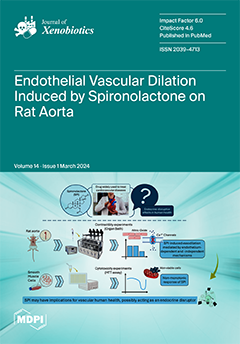Pyriproxyfen is an insecticide currently employed in numerous countries for the management of agricultural and indoor pests. Several studies indicate that this insecticide has been detected in multiple rivers, with concentrations reaching as high as 99.59 ng/L in the Júcar River in Spain. Therefore, the determination of some biochemical and genetic effects of this insecticide on aquatic organisms could serve as an early warning mechanism to identify potential disruptions in various biomarkers. Based on this,
Daphnia magna organisms were exposed to pyriproxyfen sublethal concentrations for 21 days. Some biochemical parameters, including cholesterol, triglycerides, glucose, lactate, and LDH activity, were determined. Additionally, some genetic biomarkers associated with oxidative stress, heat shock proteins, lipid metabolism, hemoglobin, metallothioneins, and vitellogenin synthesis were evaluated in daphnids exposed to the insecticide for 21 days. LDH activity increased significantly in those daphnids exposed to the highest insecticide concentration (14.02 µg/L), while cholesterol levels decreased significantly. In contrast, glucose, total proteins, and triglycerides remained unaffected in
D. magna exposed to pyriproxyfen. On the other hand, exposure to the insecticide led to notable alterations in gene expression among individuals. Specifically, genes associated with lipid metabolism and reproduction exhibited a significant reduction in gene expression. F
abd expression was decreased by approximately 20% in exposed daphnids, while
vtg expression was suppressed as much as 80% when compared to control values. Furthermore, it was observed that the
hgb1 and
hgb2 genes, associated with hemoglobin synthesis, exhibited significant overexpression. Notably, the dysfunction observed in both hemoglobin genes was linked to an increase in pigmentation in
Daphnia magna during the course of the experiment. These alterations in gene expression could serve as effective indicators of early contamination even at low pesticide concentrations.
Full article






